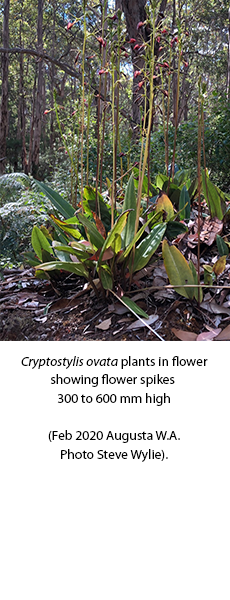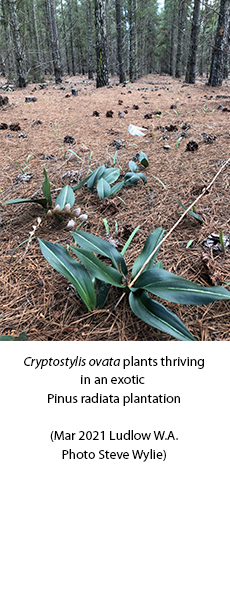<< BACK TO PROJECT LIST
Project: 340/2021
Title: Genetic diversity, mycorrhizal associations and the virome of Cryptostylis ovata, the Western Australian slipper orchid.
Applicant: Dr Steve Wylie
Institution: Murdoch University, 90 South Street, Murdoch WA 6150
Cryptostylis is a poorly-studied genus of orchids consisting of about 25 species. The genus appears to be centered in Papua New Guinea, the region where about half the species live. Other species live as far apart as Sri Lanka, Taiwan and New Zealand, and several countries in between. Australia has five indigenous species—four in eastern Australian states and one in Western Australia (WA). Our focus will be the one in the west, namely Cryptostylis ovata.
C. ovata is a mainly terrestrial orchid. Occasionally it becomes epiphytic (on live trees) and geophytic (on rocks). It is unusual among the 400+ species of indigenous terrestrial orchids from WA in that it is evergreen—it retains green leaves all year round, whereas all the other orchids are deciduous, living for some or most of the year unseen, underground. The leaves of C. ovata superficially resemble juvenile leaves of some Eucalyptus species, which they appear to mimic C. ovata flowers in the hottest and driest time of the year, and plants can have from one to about 20 flower spikes, each with a number of upside-down flowers. The flowers mimic the flightless female wasps of the species Lissopimpla excelsa, and male L. excelsa wasps enthusiastically ‘mate’ with C. ovata flowers, thereby pollinating them.
C. ovata, and other species in the genus, appears to have a very low seed germination success rate. The plants appear to be long-lived, certainly for many decades and possibly far longer. We know this because plant colonies expand slowly by underground rhizomes, yet clonal plants have been found growing many metres apart, suggestive of hundreds of years of growth.
We will study four aspects of C. ovata biology:
1. The genetic diversity of the species across its natural range.
2. The physical (morphological) diversity of the species in terms of its size, shape, colour, flowering times, flower numbers etc.
3. The range of fungal partners it forms symbiotic partnerships with.
4. The range of viruses that live with C. ovata populations.



